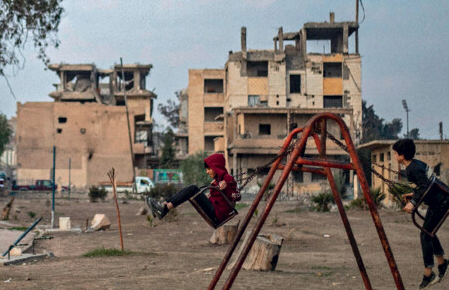
Despite the increasing number of persons fleeing across borders due to widespread violence in situations of armed conflict, there has long been a misconception that these individuals are not ‘refugees’ as defined by the 1951 United Nations Refugee Convention. The Refugee Convention defines a refugee as a person who “owing to a well-founded fear of being persecuted for reasons of race, religion, nationality, membership of a particular social group or political opinion, is outside the country of his nationality and is unable or, owing to such fear, is unwilling to avail himself of the protection of that country”. This misunderstanding has important consequences for those who, as a result, are not granted refugee protection and might be returned to an area of conflict or be granted a subsidiary form of residence status with fewer rights and entitlements than refugee status. Yet, refugee law scholarship has paid little attention to this issue. This is surprising given that most refugees today flee situations of armed conflict. In 2022, 52% of all refugees originated from just three countries, namely Syria, Ukraine and Afghanistan and the UN Refugee Agency recently emphasised the increasing number of people forced to flee new or ongoing conflicts around the world.
This is why one of the principal questions that my book, Conflict Refugees, seeks to answer is what happens when people flee armed conflicts and claim asylum in the European Union (EU). In doing so, it addresses the many misconceptions that exist concerning the recognition of persons fleeing contemporary armed conflicts as refugees under the Refugee Convention. Relying on a large body of feminist and security studies literature to better understand the changing character of contemporary armed conflicts, I demonstrate how violence in conflict is rarely indiscriminate but rather imbued with a strategic logic and often highly gendered. I make the case for understanding violence in conflict as motivated, tactical and most importantly political, thereby bringing persons at risk of violence in conflict within the confines of the Refugee Convention.
Conflict Refugees is not only a normative argument about how the Refugee Convention should be interpreted, it also investigates how judges think of armed conflict and determine the asylum appeals of persons fleeing Afghanistan, Iraq and Syria. The findings are based on a systematic and empirical comparative study of 320 appeals in five EU Member States (Belgium, Denmark, France, the Netherlands and Spain) and one former EU country (the United Kingdom) decided between 2013 and 2016.
From a legal perspective, the book explores the inter-relationship between international refugee law and other fields of international law and highlights the deficiencies of international humanitarian law and to a lesser extent international criminal law as an aid to the interpretation of the Refugee Convention definition. It points instead to international human rights law as the legal regime better suited to understanding violence in conflict and its impact on individuals by framing human rights violations from a gender perspective. Further, it argues that the Refugee Convention applies to large groups of similarly situated persons at risk from widespread violence. Historically, refugees were granted protection on a group basis and the adoption of the Refugee Convention was not intended as a departure from the protection of groups at risk. The adoption of regional refugee mechanisms containing expanded refugee definitions in Africa and Latin America was spurred by political and practical concerns specific to those regions rather than the view that the Refugee Convention definition of a refugee was lacking in its protective scope for large groups of persons fleeing widespread violence. The book claims that interpreting the Refugee Convention by the Vienna Convention on the Law of Treaties requires taking into account relevant norms of international human rights law and the nature of violence in contemporary armed conflicts. Knowledge and empirical evidence about the latter can be found in the wealth of feminist and security studies literature.
The empirical study demonstrates how EU appellate authorities’ perspective of armed conflict through the lens of conventional warfare and territoriality and their assessment of violence as indiscriminate deprives refugees of the protection of the Refugee Convention. A conventional warfare perspective, which considers that violence occurs mostly during ground confrontations between armed parties and is more serious in those sites, means that appellate authorities in the EU fail to adequately examine the general conditions of violence as a basis for refugee status. In addition, another important consequence of a conventional warfare perspective is that a real risk of violence and human rights violations directly linked to conventional fighting, such as conscription into national armies that commit crimes against peace, war crimes, or crimes against humanity and forced recruitment by non-State armed groups, is recognised as falling within the Refugee Convention ground of (imputed) political opinion. On the other hand, human rights violations taking place in sites other than the traditional battlefield, for example, rape and sexual violence at checkpoints, are not considered to be for reasons of “race, religion, nationality, membership of a particular social group or political opinion”. The focus on conventional forms of violence in conflict fails to account for fighting parties’ use of human rights violations to control populations, and by extension territory, and for non-State armed groups’ gendered targeting of (perceived) opponents based on identity politics.
Drawing on feminist and security studies literature and international human rights standards, the book presents a conceptual framework that better reflects the reality of violence in contemporary armed conflicts. It makes the case that asylum decision-makers must take this into account when determining the claims of persons fleeing widespread violence in conflict. As conflicts around the world become increasingly protracted and new conflicts erupt, the empirical findings and normative framework in Conflict Refugees are relevant to lawmakers, policy makers, asylum decision-makers, legal representatives and academics aiming to address the growing number of persons displaced across borders.

Conflict Refugees by Christel Querton
Latest Comments
Have your say!